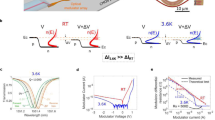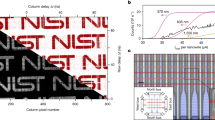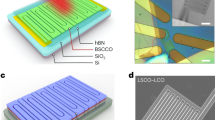Abstract
Superconducting optoelectronic hardware could be used to create large-scale and computationally powerful artificial spiking neural networks. The approach combines integrated photonic components that offer few-photon, light-speed communication with superconducting circuits that offer fast, energy-efficient computation. However, the monolithic integration of photonic and superconducting devices is needed to scale this technology. Here we report superconducting optoelectronic synapses that are created by monolithically integrating superconducting nanowire single-photon detectors with Josephson junctions. The circuits perform analogue weighting and the temporal leaky integration of single-photon presynaptic signals. Synaptic weighting is implemented in the electronic domain allowing binary, single-photon communication to be maintained. Records of recent synaptic activity are locally stored as current in superconducting loops, and dendritic and neuronal nonlinearities are implemented with a second stage of Josephson circuitry. This hardware offers synaptic time constants spanning four orders of magnitude (hundreds of nanoseconds to milliseconds). The synapses are responsive to presynaptic spike rates exceeding 10 MHz and consume approximately 33 aJ of dynamic power per synapse event before accounting for cooling. This demonstration also introduces new avenues for realizing large-scale single-photon detector arrays.
This is a preview of subscription content, access via your institution
Access options
Access Nature and 54 other Nature Portfolio journals
Get Nature+, our best-value online-access subscription
$29.99 / 30 days
cancel any time
Subscribe to this journal
Receive 12 digital issues and online access to articles
$119.00 per year
only $9.92 per issue
Buy this article
- Purchase on Springer Link
- Instant access to full article PDF
Prices may be subject to local taxes which are calculated during checkout






Similar content being viewed by others
Data availability
The data that support the findings of this study are publicly available via Figshare at https://doi.org/10.6084/m9.figshare.21277845.
References
Dicke, U. & Roth, G. Neuronal factors determining high intelligence. Phil. Trans. R. Soc. B 371, 20150180 (2016).
Herculano-Houzel, S. The human brain in numbers: a linearly scaled-up primate brain. Front. Hum. Neurosci. 3, 31 (2009).
Sterling, P. & Laughlin, S. Principles of Neural Design (MIT Press, 2015).
Hestness, J. et al. Deep learning scaling is predictable, empirically. Preprint at https://arxiv.org/abs/1712.00409 (2017).
Brown, T. et al. Language models are few-shot learners. Adv. Neural Inf. Process. Syst. 33, 1877–1901 (2020).
Koch, C. & Segev, I. The role of single neurons in information processing. Nat. Neurosci. 3, 1171–1177 (2000).
Laughlin, S. B. & Sejnowski, T. J. Communication in neuronal networks. Science 301, 1870–1874 (2003).
Schemmel, J. et al. A wafer-scale neuromorphic hardware system for large-scale neural modeling. In 2010 IEEE International Symposium on Circuits and Systems (ISCAS) 1947–1950 (IEEE, 2010).
Indiveri, G. et al. Neuromorphic silicon neuron circuits. Front. Neurosci. 5, 73 (2011).
Zenke, F. & Ganguli, S. Superspike: supervised learning in multilayer spiking neural networks. Neural Comput. 30, 1514–1541 (2018).
Kaiser, J., Mostafa, H. & Neftci, E. Synaptic plasticity dynamics for deep continuous local learning (DECOLLE). Front. Neurosci. 14, 424 (2020).
Tavanaei, A., Ghodrati, M., Kheradpisheh, S. R., Masquelier, T. & Maida, A. Deep learning in spiking neural networks. Neural Netw. 111, 47–63 (2019).
Davies, M. et al. Advancing neuromorphic computing with Loihi: a survey of results and outlook. Proc. IEEE 109, 911–934 (2021).
Beer, M., Urenda, J., Kosheleva, O. & Kreinovich, V. Why spiking neural networks are efficient: a theorem. In Information Processing and Management of Uncertainty in Knowledge-based Systems 59–69 (Springer, 2020).
Indiveri, G. & Sandamirskaya, Y. The importance of space and time for signal processing in neuromorphic agents: the challenge of developing low-power, autonomous agents that interact with the environment. IEEE Signal Process. Magazine 36, 16–28 (2019).
Liu, S.-C., Delbruck, T., Indiveri, G., Whatley, A. & Douglas, R. Event-based Neuromorphic Systems (John Wiley & Sons, 2014).
Chiles, J. et al. Multi-planar amorphous silicon photonics with compact interplanar couplers, cross talk mitigation, and low crossing loss. APL Photon. 2, 116101 (2017).
Chiles, J., Buckley, S. M., Nam, S. W., Mirin, R. P. & Shainline, J. M. Design, fabrication, and metrology of 10 × 100 multiplanar integrated photonic routing manifolds for neural networks. APL Photon. 3, 106101 (2018).
Shainline, J. M. et al. Superconducting optoelectronic loop neurons. J. Appl. Phys. 126, 044902 (2019).
Shainline, J. M. Optoelectronic intelligence. Appl. Phys. Lett. 118, 160501 (2021).
Primavera, B. A. & Shainline, J. M. Considerations for neuromorphic supercomputing in semiconducting and superconducting optoelectronic hardware. Front. Neurosci. 15, 732368 (2021).
Harada, Y. & Goto, E. Artificial neural network circuits with Josephson devices. IEEE Trans. Magn. 27, 2863–2866 (1991).
Hidaka, M. & Akers, L. An artificial neural cell implemented with superconducting circuits. Supercond. Sci. Technol. 4, 654 (1991).
Mizugaki, Y., Nakajima, K., Sawada, Y. & Yamashita, T. Implementation of new superconducting neural circuits using coupled SQUIDs. IEEE Trans. Appl. Supercond. 4, 1–8 (1994).
Rippert, E. D. & Lomatch, S. A multilayered superconducting neural network implementation. IEEE Trans. Appl. Supercond. 7, 3442–3445 (1997).
Kondo, T., Kobori, M., Onomi, T. & Nakajima, K. Design and implementation of stochastic neurosystem using SFQ logic circuits. IEEE Trans. Appl. Supercond. 15, 320–323 (2005).
Hirose, T., Asai, T. & Amemiya, Y. Pulsed neural networks consisting of single-flux-quantum spiking neurons. Physica C 463, 1072–1075 (2007).
Crotty, P., Schult, D. & Segall, K. Josephson junction simulation of neurons. Phys. Rev. E 82, 011914 (2010).
Schneider, M. et al. SuperMind: a survey of the potential of superconducting electronics for neuromorphic computing. Supercond. Sci. Technol. 35, 053001 (2022).
Primavera, B. A. & Shainline, J. M. An active dendritic tree can mitigate fan-in limitations in superconducting neurons. Appl. Phys. Lett. 119, 242601 (2021).
Shepherd, G. M. The Synaptic Organization of the Brain (Oxford Univ. Press, 2004).
Shainline, J. M. et al. Circuit designs for superconducting optoelectronic loop neurons. J. Appl. Phys. 124, 152130 (2018).
Shainline, J. M. Fluxonic processing of photonic synapse events. IEEE J. Sel. Top. Quantum Electron. 26, 1–15 (2019).
Tinkham, M. Introduction to Superconductivity (Courier, 2004).
Duzer, T. V. & Turner, C. W. Principles of Superconductive Devices and Circuits 2nd edn (Prentice Hall, 1998).
Olaya, D. et al. Planarized process for single-flux-quantum circuits with self-shunted Nb/NbxSi1−x/Nb Josephson junctions. IEEE Trans. Appl. Supercond. 29, 1–8 (2019).
Verma, V. B. et al. High-efficiency superconducting nanowire single-photon detectors fabricated from MoSi thin-films. Opt. Express 23, 33792–33801 (2015).
Lita, A. E., Verma, V. B., Chiles, J., Mirin, R. P. & Nam, S. W. MoxSi1−x: a versatile material for nanowire to microwire single-photon detectors from UV to near IR. Supercond. Sci. Technol. 34, 054001 (2021).
Buckley, S. M. et al. Integrated-photonic characterization of single-photon detectors for use in neuromorphic synapses. Phys. Rev. Appl. 14, 054008 (2020).
Zeldenrust, F., Wadman, W. J. & Englitz, B. Neural coding with bursts—current state and future perspectives. Front. Comput. Neurosci. 12, 48 (2018).
Korzh, B. et al. Demonstration of sub-3 ps temporal resolution with a superconducting nanowire single-photon detector. Nat. Photon. 14, 250–255 (2020).
Chicca, E., Stefanini, F., Bartolozzi, C. & Indiveri, G. Neuromorphic electronic circuits for building autonomous cognitive systems. Proc. IEEE 102, 1367–1388 (2014).
Mayr, C. et al. A biological-realtime neuromorphic system in 28 nm CMOS using low-leakage switched capacitor circuits. IEEE Trans. Biomed. Circuits Syst. 10, 243–254 (2015).
Beggs, J. M. The criticality hypothesis: how local cortical networks might optimize information processing. Phil. Trans. R. Soc. A 366, 329–343 (2008).
Cocchi, L., Gollo, L. L., Zalesky, A. & Breakspear, M. Criticality in the brain: a synthesis of neurobiology, models and cognition. Prog. Neurobiol. 158, 132–152 (2017).
Tomen, N., Herrmann, J. M. & Ernst, U. The Functional Role of Critical Dynamics in Neural Systems Vol. 11 (Springer, 2019).
Kheradpisheh, S. R., Ganjtabesh, M., Thorpe, S. J. & Masquelier, T. STDP-based spiking deep convolutional neural networks for object recognition. Neural Netw. 99, 56–67 (2018).
Dan, Y. & Poo, M.-m Spike timing-dependent plasticity of neural circuits. Neuron 44, 23–30 (2004).
Diehl, P. U. & Cook, M. Unsupervised learning of digit recognition using spike-timing-dependent plasticity. Front. Comput. Neurosci. 9, 99 (2015).
Bourdoukan, R. & Deneve, S. Enforcing balance allows local supervised learning in spiking recurrent networks. Adv. Neural Inf. Process. Syst. 28, 982–990 (2015).
Buckley, S. et al. All-silicon light-emitting diodes waveguide-integrated with superconducting single-photon detectors. Appl. Phys. Lett. 111, 141101 (2017).
McDonald, C. et al. III-V photonic integrated circuit with waveguide-coupled light-emitting diodes and WSi superconducting single-photon detectors. Appl. Phys. Lett. 115, 081105 (2019).
McCaughan, A. N. et al. A superconducting thermal switch with ultrahigh impedance for interfacing superconductors to semiconductors. Nat. Electron. 2, 451–456 (2019).
Onen, M. et al. Single-photon single-flux coupled detectors. Nano Lett. 20, 664–668 (2019).
Yabuno, M., Miyajima, S., Miki, S. & Terai, H. Scalable implementation of a superconducting nanowire single-photon detector array with a superconducting digital signal processor. Opt. Express 28, 12047–12057 (2020).
Ortlepp, T. et al. Demonstration of digital readout circuit for superconducting nanowire single photon detector. Opt. Express 19, 18593–18601 (2011).
Steinhauer, S., Gyger, S. & Zwiller, V. Progress on large-scale superconducting nanowire single-photon detectors. Appl. Phys. Lett. 118, 100501 (2021).
Olaya, D., Dresselhaus, P. D. & Benz, S. P. 300-GHz operation of divider circuits using high-Jc Nb/NbxSi1−x/Nb Josephson junctions. IEEE Trans. Appl. Supercond. 25, 1101005 (2015).
Acknowledgements
We appreciate the recommendations on the read-out SQUID design from B. Mates, M. Durkin and J. Aumentado. We appreciate insights on the experimental characterization from M. Castellanos-Beltran and D. Rampini. This work was made possible by the institutional support from the National Institute of Standards and Technology (award no. 70NANB18H006; B.A.P.) and the effort to advance hardware for artificial intelligence and by the DARPA Invisible Headlights Program (HR0011149863 and HR0011151332; S.K. and J.M.S.).
Author information
Authors and Affiliations
Contributions
S.K. contributed to the design of experiment, circuit concepts, circuit modelling, layout, fabrication, experimental apparatus and experimental characterization. B.A.P. contributed to the circuit modelling, experimental apparatus, experimental characterization and data analysis. J.C. contributed to the fabrication and experimental characterization. A.N.M. contributed to the circuit concepts and experimental characterization. S.M.B. contributed to the circuit concepts and experimental apparatus. A.N.T. contributed to the circuit concepts and experimental apparatus. A.L., J.B., A.F. and D.O. contributed to the fabrication process development. R.P.M. contributed to the project management. S.W.N. contributed to the project management and experimental characterization. J.M.S. contributed to the experiment design, circuit concepts, circuit modelling, layout, fabrication, data analysis and project management. All the authors contributed to the manuscript preparation.
Corresponding author
Ethics declarations
Competing interests
The authors declare no competing interests.
Peer review
Peer review information
Nature Electronics thanks Robert Dynes, Robert Hadfield and Taro Yamashita for their contribution to the peer review of this work.
Additional information
Publisher’s note Springer Nature remains neutral with regard to jurisdictional claims in published maps and institutional affiliations.
Supplementary information
Supplementary Information
Supplementary Figs. 1–14 and Sections 1–5
Rights and permissions
About this article
Cite this article
Khan, S., Primavera, B.A., Chiles, J. et al. Superconducting optoelectronic single-photon synapses. Nat Electron 5, 650–659 (2022). https://doi.org/10.1038/s41928-022-00840-9
Received:
Accepted:
Published:
Issue Date:
DOI: https://doi.org/10.1038/s41928-022-00840-9
This article is cited by
-
Superconducting circuits that mimic the brain
Nature Electronics (2022)



